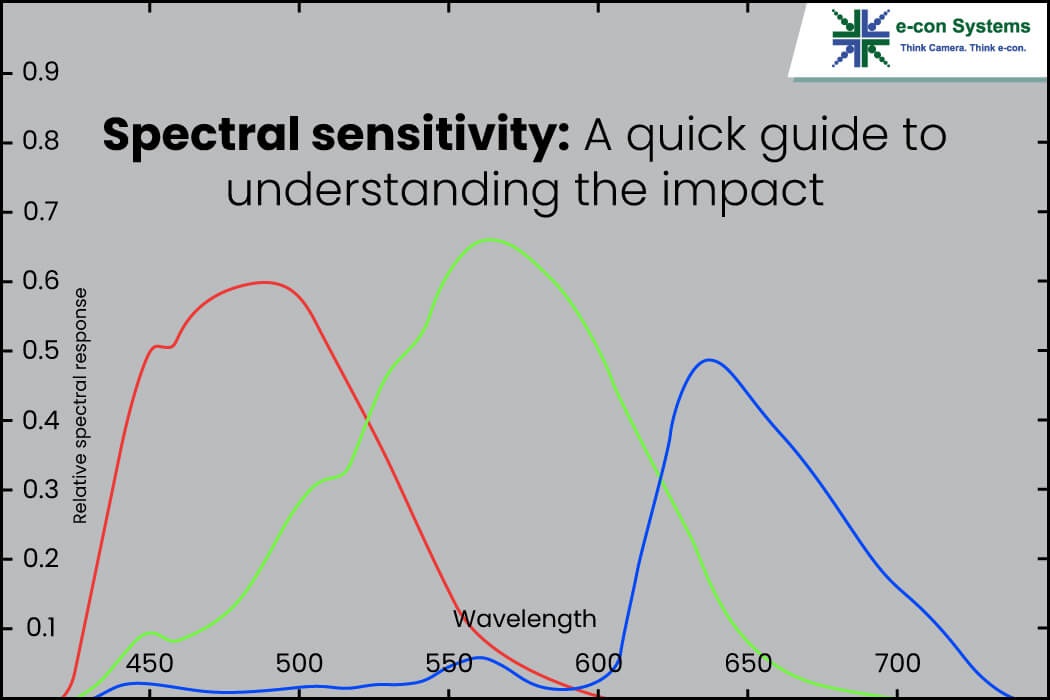Spectral sensitivity plays a major role in the world of embedded vision applications. It dictates how a sensor responds to varying wavelengths of light, which, in turn, influences the accuracy and efficacy of image capture. However, considering complex applications ranging from industrial automation to advanced biometrics, it is evident that a one-size-fits-all approach doesn’t apply. Each application has unique requirements and conditions, demanding specific spectral sensitivities for optimal performance.
Choosing the correct spectral sensitivity ensures the embedded vision system can discern and interpret images, even under challenging lighting conditions or when dealing with subtle contrasts. In this blog, you’ll discover what spectral sensitivity is, how it impacts the performance of embedded vision devices, and the factors that influence it.
What is spectral sensitivity?
Spectral sensitivity is a metric for gauging image sensors’ responsiveness to varying light wavelengths. This responsiveness is determined by the sensor’s materials and design, which collectively influence its capability to detect specific colors of light. As a result, spectral sensitivity plays a pivotal role in shaping color representation and the range of light wavelengths an image sensor can effectively capture.
2 major reasons why spectral sensitivity is crucial
This sensitivity, shaped by the sensor’s materials and design, is critical for two key reasons that impact the performance of cameras used in embedded vision devices.
Detecting a range of wavelengths
The range of wavelengths an image sensor can detect is determined by its spectral sensitivity. Consider a sensor, for instance, whose spectral sensitivity peaks in the visible spectrum, which spans from 380 to 700 nanometers. While such a sensor can capture the colors seen in everyday life, it may struggle to detect ultraviolet (UV) light that exists between 100 and 400 nanometers or infrared (IR) light beyond 1 micrometer (μm). And in case you didn’t already know, the NIR (Near Infrared) region starts from 600 nanometers.
It means sensors with limited spectrum sensitivity could miss important details, limiting their usage in settings where UV or IR imaging data is crucial.
On the other hand, a sensor with a broader spectral sensitivity, including both visible and near-infrared wavelengths, brings greater versatility to embedded vision devices. Such sensors, capable of detecting RGB and even infrared light, open the door to a larger range of uses, from color recognition to night vision. This broad sensitivity is frequently caused by the composition of the sensor, which contains components sensitive to visible and near-infrared light.
Impact on color reproduction
Spectral sensitivity influences color reproduction, an essential aspect of image quality. Imagine a scenario where a camera’s sensor exhibits poor spectral sensitivity—biased towards green light but less responsive to red and blue wavelengths. In this instance, capturing a vibrant sunset scene could pose challenges. The camera might struggle to faithfully capture the vivid reds and oranges of the sky, leading to washed-out images that fail to represent the true colors of the scene.
Solving this issue necessitates sensors with balanced spectral sensitivity capable of accurately capturing a full spectrum of colors. Cameras with well-calibrated spectral sensitivity can reproduce colors precisely, ensuring that images retain their true vibrancy and authenticity.
3 factors that shape the spectral sensitivity of image sensors
Temperature of the sensor
Temperature stands as a potent factor as the sensitivity of sensors fluctuates while warming up or cooling down. It leads to potential shifts in color responsiveness. Extreme temperatures may skew color representation, affecting the sensor’s accuracy in capturing true-to-life hues. Hence, maintaining a consistent temperature range is crucial to ensure optimal spectral sensitivity and prevent accidental distortions in color reproduction.
Exposure time
A sensor’s sensitivity can evolve over longer exposure periods, affecting its ability to capture specific wavelengths accurately. Longer exposure times can lead to more comprehensive light absorption, enhancing the sensor’s responsiveness to various colors. So, striking a balance is vital, as overly prolonged exposures can invite noise and compromise image quality.
Gain setting
The gain setting increases the sensor’s responsiveness to light wavelengths. By adjusting the gain, users can enhance the sensor’s ability to capture faint light or distinguish subtle color nuances. However, an indiscriminate increase in gain can introduce unwanted noise and degrade image quality. That’s why finding the optimal gain setting is important to harness spectral sensitivity’s potential while maintaining image integrity.
Cameras with a wide spectral sensitivity range by e-con Systems
e-con Systems, with over two decades of experience, has built several cameras that deliver excellent image quality in both visible and near-IR regions. They come with advanced features like High Dynamic Range (HDR), on-board ISP, low latency, motion detection sensor, fixed focus, and more. These cameras include:
- RouteCAM_CU20 – Sony® Starvis™ IMX462 Full HD GigE Camera
- See3CAM_CU83 – 4K AR0830 RGB-IR USB 3.2 Gen 1 Camera
- See3CAM_CU135M – 4K Monochrome USB 3.1 Gen 1 Camera
- See3CAM_CU512M – 5MP AR0522 Monochrome NIR USB camera
- See3CAM_20CUG – 2MP OV2311 Monochrome Global Shutter Camera
- See3CAM_27CUG – 2MP OV2312 Global Shutter RGB-IR USB 3.2 Gen 1 Camera
e-con Systems also provides extensive customization services like form factor changes, lens mount modifications, and enclosure design – ensuring that our camera solutions meet your unique use case demands.
Visit our Camera Selector page for a comprehensive view of our products.
No matter which sensor is best for your embedded vision product, if you need help integrating cameras, email us at camerasolutions@e-consystems.com.

Prabu is the Chief Technology Officer and Head of Camera Products at e-con Systems, and comes with a rich experience of more than 15 years in the embedded vision space. He brings to the table a deep knowledge in USB cameras, embedded vision cameras, vision algorithms and FPGAs. He has built 50+ camera solutions spanning various domains such as medical, industrial, agriculture, retail, biometrics, and more. He also comes with expertise in device driver development and BSP development. Currently, Prabu’s focus is to build smart camera solutions that power new age AI based applications.




